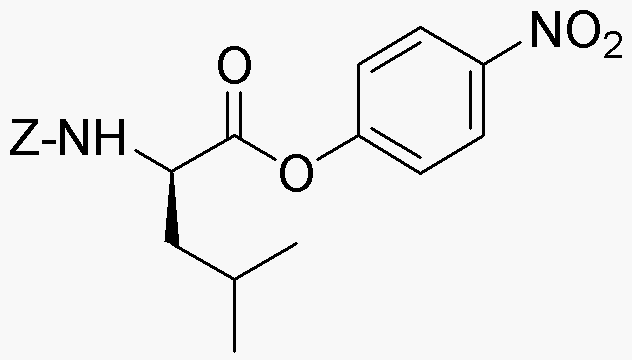Z-D-leucine 4-nitrophenyl ester is widely utilized in research focused on:
- Peptide Synthesis: This compound serves as a valuable building block in the synthesis of peptides, enabling researchers to create complex structures for various applications in biochemistry and pharmacology.
- Drug Development: It plays a crucial role in the development of new pharmaceuticals, particularly in designing drugs that target specific biological pathways, enhancing therapeutic efficacy.
- Bioconjugation: The compound is used in bioconjugation processes, allowing scientists to attach biomolecules to surfaces or other molecules, which is essential in creating targeted drug delivery systems.
- Research in Enzyme Inhibition: It is applied in studies aimed at understanding enzyme mechanisms, helping researchers identify potential inhibitors that could lead to new treatments for diseases.
- Protein Engineering: This chemical is instrumental in protein engineering, where it aids in modifying proteins to improve their stability and functionality for industrial and therapeutic uses.
General Information
Properties
Safety and Regulations
Applications
Z-D-leucine 4-nitrophenyl ester is widely utilized in research focused on:
- Peptide Synthesis: This compound serves as a valuable building block in the synthesis of peptides, enabling researchers to create complex structures for various applications in biochemistry and pharmacology.
- Drug Development: It plays a crucial role in the development of new pharmaceuticals, particularly in designing drugs that target specific biological pathways, enhancing therapeutic efficacy.
- Bioconjugation: The compound is used in bioconjugation processes, allowing scientists to attach biomolecules to surfaces or other molecules, which is essential in creating targeted drug delivery systems.
- Research in Enzyme Inhibition: It is applied in studies aimed at understanding enzyme mechanisms, helping researchers identify potential inhibitors that could lead to new treatments for diseases.
- Protein Engineering: This chemical is instrumental in protein engineering, where it aids in modifying proteins to improve their stability and functionality for industrial and therapeutic uses.
Documents
Safety Data Sheets (SDS)
The SDS provides comprehensive safety information on handling, storage, and disposal of the product.
Product Specification (PS)
The PS provides a comprehensive breakdown of the product’s properties, including chemical composition, physical state, purity, and storage requirements. It also details acceptable quality ranges and the product's intended applications.
Certificates of Analysis (COA)
Search for Certificates of Analysis (COA) by entering the products Lot Number. Lot and Batch Numbers can be found on a product’s label following the words ‘Lot’ or ‘Batch’.
Numéro de catalogue
Numéro de lot/série
Certificates Of Origin (COO)
This COO confirms the country where the product was manufactured, and also details the materials and components used in it and whether it is derived from natural, synthetic, or other specific sources. This certificate may be required for customs, trade, and regulatory compliance.
Numéro de catalogue
Numéro de lot/série
Safety Data Sheets (SDS)
The SDS provides comprehensive safety information on handling, storage, and disposal of the product.
DownloadProduct Specification (PS)
The PS provides a comprehensive breakdown of the product’s properties, including chemical composition, physical state, purity, and storage requirements. It also details acceptable quality ranges and the product's intended applications.
DownloadCertificates of Analysis (COA)
Search for Certificates of Analysis (COA) by entering the products Lot Number. Lot and Batch Numbers can be found on a product’s label following the words ‘Lot’ or ‘Batch’.
Numéro de catalogue
Numéro de lot/série
Certificates Of Origin (COO)
This COO confirms the country where the product was manufactured, and also details the materials and components used in it and whether it is derived from natural, synthetic, or other specific sources. This certificate may be required for customs, trade, and regulatory compliance.


